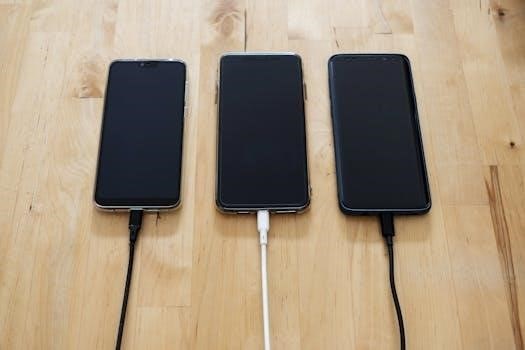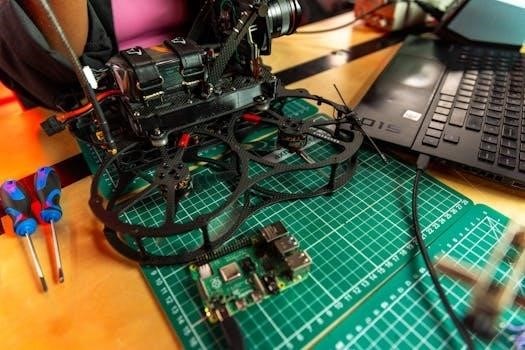
cat battery charger manual
Cat Battery Charger Manual⁚ A Comprehensive Guide
Welcome to the comprehensive guide for Cat battery chargers! This manual provides essential instructions for operating and maintaining your Cat battery charger safely and effectively, ensuring optimal performance and longevity․
Cat battery chargers are designed to efficiently charge and maintain lead-acid batteries, enhancing their lifespan․ These chargers often feature automatic operation, adjusting the charging rate based on the battery’s condition․ Some models include jump-starting capabilities and power inverter functionality, providing versatile solutions for various power needs․ Always prioritize safety and carefully read the instruction manual before use․ Proper charging is crucial for optimal battery performance and longevity․ Regularly inspect the charger for wear and tear․ Cat chargers are not intended for dry-cell batteries․ Ensure the charger is used within the specified voltage and amperage range․ Familiarize yourself with the charger’s features․

Understanding Cat Battery Charger Models
Cat battery chargers come in various models, each tailored for specific battery types and charging needs․ Understanding the features of each model is crucial for selecting the appropriate charger for your application․
Common Models and Their Features
Several Cat battery charger models are available, each designed with unique features․ For instance, the CAT CD1000DCP is a 3-in-1 power station with jump-starting capabilities and a power inverter․ Some models offer fully automatic charging with engine start assistance, like the 25 AMP charger․ Features include USB charging ports, DC accessory outlets, and integrated power inverters․
Certain models are designed for specific battery types, such as lead-acid batteries․ Always refer to the product manual for detailed specifications and compatibility․ Understanding these features ensures you select the right model for your needs․
Safety Precautions
Prioritize safety when using Cat battery chargers․ Always follow instructions and heed warnings․ Failure to comply can result in electric shock, fire, or serious injury․ Periodically inspect the charger for wear and tear․
General Safety Guidelines
Before operating any Cat battery charger, carefully read and understand the entire instruction manual․ Ensure the work area is well-ventilated and free from flammable materials․ Always wear appropriate eye protection and avoid contact with battery acid․ Never smoke or allow open flames near the battery during charging․ Confirm that the charger’s voltage matches the battery’s voltage․ Disconnect the charger from the power source before connecting or disconnecting the battery clamps․ Attach clamps to the correct terminals, observing polarity․ Do not use the charger for purposes other than charging lead-acid batteries․ Regularly inspect the charger’s cords and clamps for damage․ Seek professional repairs if necessary․ Store the charger in a dry, secure location when not in use․ These precautions help prevent accidents and ensure safe operation․
Specific Warnings for Cat Battery Chargers
Avoid using Cat battery chargers on dry-cell batteries, as they may burst and cause injury․ Immediately charge the unit fully (around 40 hours) upon receipt to ensure optimal performance․ Always connect the negative clamp to the vehicle chassis, away from fuel lines, never directly to the negative battery terminal․ Do not attempt to disassemble or modify the charger, as this may result in electric shock or fire․ Regularly check the battery status indicator during charging to prevent overcharging․ If the charger malfunctions or emits unusual noises, disconnect it immediately․ Ensure the charger is placed on a stable surface during operation․ Keep the charger away from water and moisture․ Only use recommended extension cords if necessary․ Ensure the charger is compatible with your battery type․ Ignoring these specific warnings could lead to serious harm or damage․

Charging Procedures
This section details proper charging procedures for Cat battery chargers․ Learn step-by-step instructions for optimal charging, initial setup, and routine maintenance to maximize battery life and performance․
Step-by-Step Charging Instructions
To begin charging your Cat battery, first, ensure the charger is disconnected from the power source․ Next, connect the positive (red) clamp to the positive terminal of the battery․ Then, connect the negative (black) clamp to the vehicle chassis or a non-moving metal part, away from the fuel line and battery․
After making secure connections, plug the charger into a grounded AC outlet․ Select the appropriate charging mode based on the battery type and size․ Monitor the charging process via the LED indicators, and once fully charged, disconnect the charger from the AC outlet before removing the clamps․
Initial Charging and Maintenance
Upon receiving your Cat battery charger, it’s crucial to perform an initial full charge for approximately 40 hours․ This initial charge ensures the internal battery reaches its maximum capacity, optimizing performance․ Use a household extension cord to connect to a power outlet․ The battery status icon should show solid bars upon full charge․
For regular maintenance, periodically check the charger for wear and tear․ Routinely charge the battery to maintain a full charge, extending the battery life․ Lead-acid batteries require routine maintenance to ensure longevity․ Remember to store the charger in a dry, cool place when not in use․
Troubleshooting
Encountering issues? This section addresses common problems with Cat battery chargers; We provide solutions for charging difficulties, error messages, and operational malfunctions to help you resolve issues efficiently and safely․
Common Issues and Solutions
If your Cat battery charger isn’t charging, ensure the AC adapter is correctly connected and the power outlet functions․ A flashing LED often indicates a problem; consult the manual for specific error codes․ Verify the battery clamps are securely attached to the correct terminals, black to negative and red to positive, and are free from corrosion․
For units that shut down prematurely, check for overheating and allow it to cool․ If the jump-start function fails, ensure the battery voltage of the vehicle is within the charger’s specified range․ Always refer to the charger’s manual․

Maintenance and Storage
To ensure longevity, regularly inspect your Cat battery charger for wear and tear․ Store it in a dry, cool place, and clean the clamps after each use to prevent corrosion and maintain optimal performance․
Proper Care for Longevity
To maximize the lifespan of your Cat battery charger, consistent maintenance is crucial․ Begin by regularly inspecting the charger’s cables, clamps, and housing for any signs of damage, such as cracks or fraying․ Clean the clamps after each use to remove dirt and corrosion, ensuring a good connection for future charging sessions․ When not in use, store the charger in a dry, climate-controlled environment, away from extreme temperatures and humidity․ Avoid wrapping the cables too tightly, as this can damage the internal wiring․ Periodically check the battery status indicator and voltage to ensure the internal battery is functioning correctly․
Jump Starting with Cat Battery Chargers
Cat battery chargers often include a jump-start function․ This section details how to safely and effectively use this feature to revive a dead battery, providing a quick and reliable power boost when needed․
Using the Jump Start Function
To utilize the jump-start function on your Cat battery charger, first, ensure both vehicles are turned off․ Connect the red clamp to the positive (+) terminal of the discharged battery․ Then, connect the black clamp to a solid, unpainted metal part of the vehicle’s chassis, away from the battery and fuel lines․
Next, power on the Cat battery charger and select the jump-start mode, following the specific instructions in your charger’s manual․ Attempt to start the vehicle․ If it doesn’t start immediately, wait a few minutes and try again․ Avoid prolonged cranking․ Once started, disconnect the clamps in reverse order․

Power Inverter Functionality (if applicable)
Some Cat battery chargers come equipped with a power inverter․ This feature allows you to power AC devices using the charger’s DC battery, providing convenient portable power for various applications․
Utilizing the Inverter for AC Power
If your Cat battery charger includes an integrated power inverter, you can utilize it to power various AC devices․ First, ensure the battery is adequately charged․ Locate the AC outlet on the charger, usually protected by a cover․ Connect your desired AC device to the outlet․ Turn on the inverter, following the specific instructions in your model’s manual․ Be mindful of the inverter’s wattage capacity and do not exceed it to prevent damage․ The inverter is ideal for small electronics and appliances․ Always disconnect the device when not in use․ This extends both the inverter and battery life, ensuring reliable power when needed․
Warranty Information
Your Cat battery charger comes with a warranty covering manufacturing defects․ Refer to the included documentation for specific terms, duration, and claim procedures․ Keep your purchase receipt for warranty validation purposes․
Details on Cat Battery Charger Warranties
Cat battery chargers typically include a limited warranty against defects in materials and workmanship․ The warranty period can vary depending on the specific model and region, so it’s crucial to consult the warranty card or the user manual provided with your charger for accurate details․ This warranty usually covers repair or replacement of defective parts, excluding damages caused by misuse, neglect, unauthorized modifications, or improper charging procedures․
To claim warranty service, retain your original purchase receipt or proof of purchase․ Contact the authorized Cat service center or retailer for assistance, providing them with the necessary documentation and a clear description of the issue you’re experiencing․
Related posts:
Archives
Calendar
| M | T | W | T | F | S | S |
|---|---|---|---|---|---|---|
| 1 | 2 | 3 | 4 | 5 | 6 | 7 |
| 8 | 9 | 10 | 11 | 12 | 13 | 14 |
| 15 | 16 | 17 | 18 | 19 | 20 | 21 |
| 22 | 23 | 24 | 25 | 26 | 27 | 28 |
| 29 | 30 | 31 | ||||
Leave a Reply
You must be logged in to post a comment.